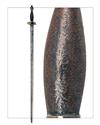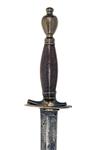Product Details
EX PROPERTY OF LORD GEORGE GORDON
AN HISTORIC BRITISH 1786 PATTERN STYLE SWORD,
with single edged broad fullered 33in. spear-point blade, kidney shaped brass guard, originally double-sided, one side now cut flat for wall-mounting, the knuckle-guard and quillion broken off and absent, faceted urn pommel and wood grip missing binding, the grip inscribed 'THIS SWORD WAS WORN BY LORD GEORGE GORDON DURING THE ANTI-PAPIST RIOTS AND BROKEN AT THE BURNING OF NEWGATE, 1780'
Other Notes: George Gordon was born in London on the 26th December, 1751, the third and youngest son of the 3rd Duke Gordon. After completing his education at Eton, he joined the Navy in 1763 aged only 12, quickly promoting to Lieutenant. Unfortunately, his modern thinking and constant arguing with his superiors to increase the living standards and welfare of sailors forced his career into stagnation and after failing to gain promotion to command his own vessel he resigned his commission in 1772.
Despite appearing to others as unfocused and flighty, Gordon, now Lord George, decided to enter politics and contest the seat of Inverness-shire. In order to stamp out someone who he thought to be an impertinent little upstart, his opponent in Inverness-shire, General Fraser, bought him the safe seat of Luggershall (basically as a bribe) so he would not contest the county. Considered of little importance and removed to the other end of the country, Lord George entered the Houses of Parliament where he was soon to make a name for himself, becoming a staunch supporter of American independence (at this point the American war of Independence was raging) and arguing with just about everyone from the then Prime Minister to his own supporters. His next target was the Catholics…
In 1779 Lord George organised The Protestant Association, appointing himself as the head. Its main purpose was to repeal the Papist Act of 1778, which had restored civil rights and liberties to certain Catholics prepared to swear an allegiance to the Crown. Things came to a head on the 2nd June 1780 when he headed a crowd of around 50,000 protesters that proceeded to march from St George's Fields, just south of London with a petition demanding the revocation of Catholic rights, towards the Houses of Parliament. Upon reaching Westminster a huge riot broke out, with the crown initially appearing to disperse, but over the next few days roaming gangs of protesters destroyed several Roman Catholic chapels, pillaged many private Catholic dwellings, freed prisoners from all the jails, attacked the Bank of England and several other public buildings. Lord George's own mob went one step further at Newgate Prison by setting it alight as well. The army was called, and around 450-500 people were killed or wounded before the unrest was quelled. Lord George was arrested and charged with High Treason. Because of his title, he was comfortably imprisoned in the Tower of London and allowed to receive visitors who included the Methodist leader, the Rev. John Wesley. Strongly defended by his cousin, Lord Erskine, he was soon acquitted on the grounds that he had no treasonable intent.
Events were to turn downhill rapidly however. In 1786 he was excommunicated by the Archbishop of Canterbury for refusing to bear witness in an ecclesiastical suit; and in 1787 he was convicted of defaming Marie Antoinette, the French ambassador and the administration of justice in England. He was, however, permitted to withdraw from the court without bail, and made his escape to the Netherlands. He also converted to Judaism. On account of representations from the Court of Versailles, he was commanded to leave France, and, on returning to England was apprehended and in January 1788 sentenced to five years' imprisonment in Newgate with some harsh additional conditions. Despite this he was a model prisoner and a great comfort to others imprisoned with him. He served out his sentence, and in 1793 left Newgate. Unfortunately for him, he took with him a gift from the prison - typhoid fever- to which he succumbed aged 42 in November 1793.
Please click HERE to view Terms & Conditions.
Estimate £350-500





